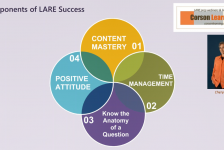“How Different is the 2017 LARE?” Webinar
May 31, 2017
For any LARE (Landscape Architect Registration Examination) candidate, knowing what to study given limited preparation resources is key. In 2012 the exam changed so that hand drawing was no longer used, and design, grading, and drainage became computer based. New verbal and graphic questions in various formats were developed for the first time. This was a dramatic shift in the exam’s history, and by now we’ve mostly adapted to this new format, which remains unchanged for 2017 exam cycles.
LARE Exam Format & Content Development
Underlying the exam format is the content to be tested, which is evaluated by CLARB (Council of Landscape Architectural Registration Boards) every five to seven years through a “task analysis,” a survey sent to about 20,000 professionals, asking what type of work landscape architects regularly do. CLARB says periodic task analyses keep the exam “legally defensible and relevant,” important because state and provincial licensing boards need trust in the exam’s ability to help ensure the protection of public health, safety, and welfare. Sample test questions from 20 years ago seem very different from those of today. Evolution is good, especially since content changes come from the field, not by administrators.
The most recent task analysis was completed in 2016. Out of 20,000 surveys sent, 3,488 respondents practicing in the US, Canada, and Puerto Rico completed the survey. The previous task analysis overlapped with the exam format change in 2012, but we’re told that the Recession resulted in few changes that time. Now that the economy is more active, it’s not surprising to see some content change as announced on CLARB’s website.
How Many Questions?
Between November 2016 and February 2017, the CLARB website said that the number of questions for each of the four LARE sections had been reduced. For Sections 1 & 3, it said, instead of 100 questions, there would now be 85. Section 2 would go from 80 questions down to 70. Section 4 would go from 120 questions down to 105. This seemed like a nice change.
In mid-February, the CLARB website’s page listing the number of questions changed so that a new question category was added, increasing the total number of questions back up to where it had been since 2012. The new question category was called, “pretest items.” See CLARB’s LARE Orientation here.
Now we know how many questions are being field tested (my term) and don’t count toward your score. However, resist the assumption that any question you may be having a hard time with doesn’t count toward your score! If you downloaded the CLARB LARE Orientation during or prior to February 2017, make sure you have the most recent edition.
Even though no one divides their time per question evenly, it’s helpful to know how much time is allotted per question for each section. For section 1, one and a half minutes; section 2, 1.9 minutes, section 3, 2.1 minutes, and section 4, an even two minutes. Gain confidence by setting a timer for 90 seconds and imagining answering one question in that time. It’s going to feel long. With planning, the LARE does not necessarily present time challenges.
New and Rearranged Exam Content
Here are a few pointers on new content:
Section 1 – Project and Construction Management: Landscape maintenance is a new exam subject which now represents 10% of exam content. Some construction administration previously found on Section 4 has been moved to Section 1. Obtaining permits and cost estimates and collecting and analyzing performance metrics now appear in this section.
Section 2 – Inventory and Analysis: In my opinion, this section is least affected by the 2016 task analysis. Some new content called out on the CLARB LARE Orientation Guide are, “Gather stakeholder input, identify policy objectives, determine appropriate types of analyses, and interpret all sorts of site analysis data.”
Section 3 – Design: The new content area called, “Stakeholder Process” now represents 9% of this exam, which is new. Some items seem to have migrated from Section 4 into Section 3, such as, “Develop Historic/Cultural Restoration and Preservation Plan.” Other new content includes, “prepare preliminary quantities and cost estimates, and identify and develop performance metrics.” Note that this overlaps with Section 1 to a degree.
Section 4 – Grading, Drainage and Construction Documentation: New in this section are, “develop mitigation plan, develop traffic control plan and emergency access plan.” And as we know, erosion and sediment control are important to know in this section, though it is not called out by this name in CLARB’s bulleted list.
Published in Blog




